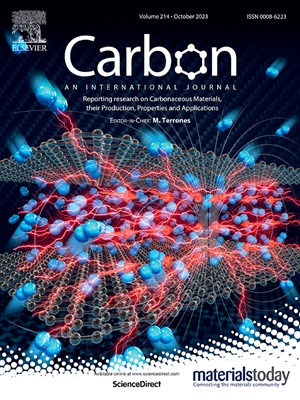Novel ultralight carbon foam reinforced carbon aerogel composites with low volume shrinkage and excellent thermal insulation performance
IF 10.5
2区 材料科学
Q1 CHEMISTRY, PHYSICAL
引用次数: 0
Abstract
Lightweight carbon aerogels are attractive for thermal insulation due to their low thermal conductivity and excellent high-temperature resistance under extreme environments. However, the preparation of monolithic carbon aerogels from phenolic resin precursor always faces the problem of large volumetric shrinkage during the drying and carbonization processes, thus resulting in the increasing density and thermal conductivity of aerogels. Here, to solve such issues, ultralight and rigid carbon foam was designed and synthesized as the reinforcement to fabricate carbon aerogel composites (CACs), which could significantly enhance the shrinkage resistance of monolithic carbon aerogels. The high rigidity of the carbon foam reinforcements (CFRs) was achieved through a pre-carbonization process, which also endowed the CFRs with a matched shrinkage with the monolithic carbon aerogels. As a result, the obtained CACs reinforced by the rigid CFRs showed not only crack-free structures, but also quite low shrinkage, which was about 5.9 % after carbonization. The low shrinkage of CACs then endowed them with quite low density (21.5 mg cm−3) and excellent thermal insulation performance (25.9 mW m−1 K−1). Furthermore, due to a highly rough nanostructure, the CACs also possessed outstanding hydrophobicity. These merits make the CACs a promising thermal insulation material even in humid environments.
具有低体积收缩和优异隔热性能的新型超轻碳泡沫增强碳气凝胶复合材料
本文章由计算机程序翻译,如有差异,请以英文原文为准。
求助全文
约1分钟内获得全文
求助全文
来源期刊

Carbon
工程技术-材料科学:综合
CiteScore
20.80
自引率
7.30%
发文量
0
审稿时长
23 days
期刊介绍:
The journal Carbon is an international multidisciplinary forum for communicating scientific advances in the field of carbon materials. It reports new findings related to the formation, structure, properties, behaviors, and technological applications of carbons. Carbons are a broad class of ordered or disordered solid phases composed primarily of elemental carbon, including but not limited to carbon black, carbon fibers and filaments, carbon nanotubes, diamond and diamond-like carbon, fullerenes, glassy carbon, graphite, graphene, graphene-oxide, porous carbons, pyrolytic carbon, and other sp2 and non-sp2 hybridized carbon systems. Carbon is the companion title to the open access journal Carbon Trends. Relevant application areas for carbon materials include biology and medicine, catalysis, electronic, optoelectronic, spintronic, high-frequency, and photonic devices, energy storage and conversion systems, environmental applications and water treatment, smart materials and systems, and structural and thermal applications.
 求助内容:
求助内容: 应助结果提醒方式:
应助结果提醒方式:


